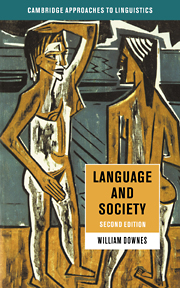Book contents
- Frontmatter
- Contents
- Acknowledgements
- 1 Linguistics and sociolinguistics
- 2 A tapestry in space and time
- 3 Language varieties: processes and problems
- 4 Discovering the structure in variation
- 5 Rhoticity
- 6 At the intersection of social factors
- 7 Change, meaning and acts of identity
- 8 The discourse of social life
- 9 Communication: words and world
- 10 Action and critique
- 11 Language and social explanation
- Further reading
- References
- Index
9 - Communication: words and world
Published online by Cambridge University Press: 05 June 2012
- Frontmatter
- Contents
- Acknowledgements
- 1 Linguistics and sociolinguistics
- 2 A tapestry in space and time
- 3 Language varieties: processes and problems
- 4 Discovering the structure in variation
- 5 Rhoticity
- 6 At the intersection of social factors
- 7 Change, meaning and acts of identity
- 8 The discourse of social life
- 9 Communication: words and world
- 10 Action and critique
- 11 Language and social explanation
- Further reading
- References
- Index
Summary
Verbal communication involves both code and inferential processes.
Sperber and Wilson (1995)Limits of semantics
Consider the following utterances:
Brenda: I'm pregnant … and it's your fault.
Brenda: I told you to be careful
Arthur: How do you know?
Brenda: I'm twelve days late.
Arthur: How do you know it's mine?
Brenda: I ain't done owt like that with Jack for a couple of months or more.
Arthur: Well, have yet tried owt? Took owt I mean?
Brenda: Yes, took pills but they didn't work.
If we reflect on the semantics – the meanings of the words and sentences taken by themselves – it is clear that such meanings fall far short of what is required to comprehend either what the participants are intending to convey or how the utterances connect with one another to form a coherent text.
The sentence and word meanings of a language are the coded part of what a sentence conveys when uttered. Such coded meanings are connected to the sounds by convention and conveyed in any occasion of use. Now look at sentence 4: ‘I'm twelve days late.’ What is encoded by the semantic structure of this sentence? All Brenda literally says is that she is late by twelve days. Resolving the expressions that depend on the context of utterance we can paraphrase the coded meaning of 4 as: ‘Brenda is now, at the moment of speech, twelve days after the due or customary time.’
- Type
- Chapter
- Information
- Language and Society , pp. 323 - 367Publisher: Cambridge University PressPrint publication year: 1998



